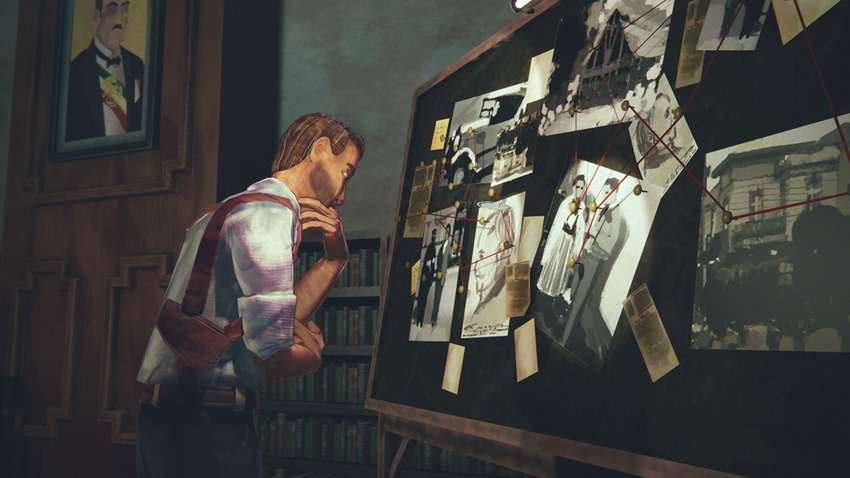.png?width=700&auto=webp&quality=80&disable=upscale)
Macula Interactive breaks down the photography mechanic that will allow players to explore post-revolutionary Mexico as photojournalist Juan Aguirre.

Mácula Interactive's narrative adventure Mexico, 1921: A deep slumber has been making waves of late, grabbing an AMAZE Award nomination and making it into the official selection at London Games Festival 2023.
Although the title is still in development, Mácula–an 11-person indie outfit based in Mexico City–is evidently doing something right. The studio described Mexico, 1921 as a slice of historical fiction that charts the "awakening of a country" by asking players to take on the role of young photojournalist, Juan Aguirre, and immerse themselves in a world grappling with social and political revolution.
During a chat at GDC 2023, Mexico, 1921 general director Paola Vera explained the game's core photography mechanic was absolutely non-negotiable, largely because Mexico in the 1920's had "more than a 90 percent illiterate rate." In pursuing authenticity, the studio realized the main character would need to utilize photography to tell a story that would have resonated with the people of Mexico over 100 years ago.
Vera, however, explained that creating a photography mechanic that felt historically accurate, compelling, and distinct to others that have come before was a fairly hefty undertaking. "We wanted to replicate how hard it was to take pictures in that time," she said, "because we're so used to just picking up a phone and snapping away. So, the mechanic of the camera was fundamental to the experience because you take pictures as part of your journalism journey, discovering narrative beats and collecting evidence, but it's also a tool for the player to enjoy the scenery."
Snapshots of history
The main challenge in Mexico, 1921 is "understanding." Both understanding the mystery at the game's core and the changing socio-economic landscape that surrounds players. That meant the camera had to serve two purposes, doubling as a device that drives the narrative forward while also serving as a tool for engaging with the beautiful world Mácula has crafted, which is influenced by the realist art and murals of painters like David Alfaro Siqueiros and Diego Rivera.
Vera explained the camera in Mexico, 1921 is actually a mixture of two vintage models: the Rolleiflex, made by German company Franke & Heidecke, and the Yashica-D, which was manufactured by Japanese camera maker Yashica. She noted the team decided to meld the two together because the Rolleiflex has a tiny viewfinder, which wouldn't be practical for gameplay. But by combining the overall style of the Rolleiflex with the larger viewfinder and (slightly) more modern sensibilities of the Yashica-D (which launched in 1958), the team was able to create something that would meet the gameplay and mechanical needs of players (letting them easily tinker with depth of field, aperture and zoom) without causing a huge amount of ludonarrative dissonance.
In-game, it's only possible to use the camera by looking into a vertical viewfinder (as shown below), creating something of a disconnect between players and the scene around them. It was an intentional design choice that Mácula hopes will challenge players used to more traditional photography games that might ask them to simply point-and-shoot at objects that catch their eye.

"We wanted it to be a unique way to look into a camera, because when you hold an old camera you don't look up. You always look down. That was something we really loved because it feels different to take pictures that way," said Vera. "Some people have told us 'I don't like it, because I'm looking at the floor,' [...] but it forces players to be careful with their surroundings, which is perhaps something we're not used to anymore."
Vera said the photography mechanic only took a couple of months before it was in a stable place, adding that Mácula wanted to finalize that specific element of the game before thinking about how it would fit into the wider narrative so the studio could avoid creating a 'Pokémon Snap in Mexico.'"
To that end, the team fleshed out its recreation of Mexico City, filling the game's seven "fishbowl" levels with almost 200 NPCs that make environments feel densely populated. As players explore those levels, they'll be able to lean in to Juan's journalistic sensibilities by entering "nosy mode," allowing him to listen into certain conversations and find important objects that might have otherwise escaped notice. In doing so, they'll be able to collect props and other items that will help them understand why Mexico, in the words of Mácula, "ain't no place for the weak."

Vera and the rest of the Mácula team hope their unique approach to photography will encourage players to really think about what they're capturing, highlighting the cultural significance and historical importance of those scenes. "You have to explore a lot of spaces that aren't currently accessible in Mexico. For example, the Convento de la Merced is in one of our levels. It's a beautiful building that was built in 1676, but it's not currently accessible in Mexico because they've been trying to renovate it for the past 25 years. In this game, though, you get to explore it.
"In fact, a lot of the objects you can collect and interact with are part of the popular arts museum in Mexico City. We've modelled them into the game, and they comprise the clues that Juan needs to get from A to B. [...] You'll need to take pictures [of some of those things] as part of your photojournalism journey–crucially, you have to take good pictures because no bad pictures ever made the front page–and that's what pulls it all together. When you get your evidence, you'll complete your story."
Read more about:
FeaturesAbout the Author(s)
You May Also Like









